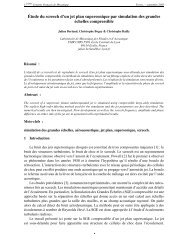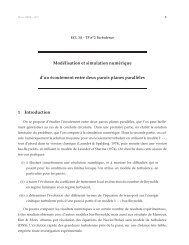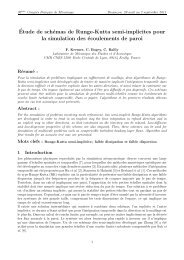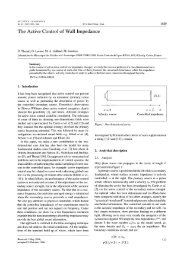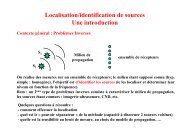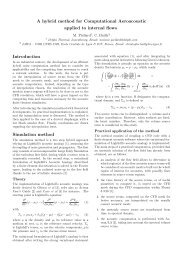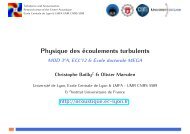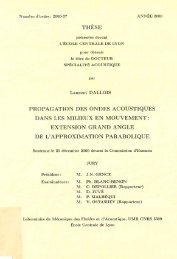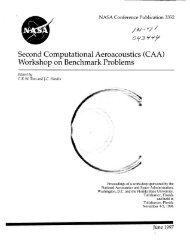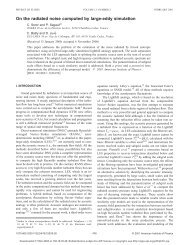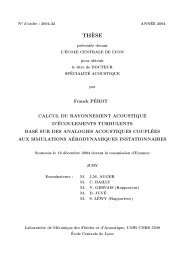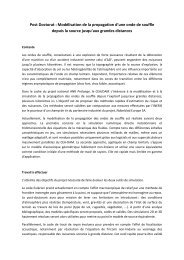Analyse de la propagation acoustique à bassealtitude par équation ...
Analyse de la propagation acoustique à bassealtitude par équation ...
Analyse de la propagation acoustique à bassealtitude par équation ...
Create successful ePaper yourself
Turn your PDF publications into a flip-book with our unique Google optimized e-Paper software.
ANALYSE DE LA PROPAGATION ACOUSTIQUE A BASSE ALTITUDE<br />
PAR L'EQUATION PARABOLIQUE TRIDIMENSIONNELLE<br />
<strong>par</strong> Yves DELRIEUX<br />
Résumé - L'étu<strong>de</strong> <strong>de</strong> <strong>la</strong> <strong>propagation</strong> <strong>acoustique</strong> <strong>à</strong> basse altitu<strong>de</strong> connaît un intérêt grandissant dans<br />
le but <strong>de</strong> réduire les nuisances <strong>à</strong> proximité <strong>de</strong>s industries, du trafic routier ou <strong>de</strong>s aéroports. Cette<br />
étu<strong>de</strong> peut être menée en résolvant numériquement une <strong>équation</strong> d'on<strong>de</strong>. Deux approches<br />
c<strong>la</strong>ssiques <strong>de</strong> <strong>la</strong> solution <strong>de</strong> cette <strong>équation</strong> sont <strong>la</strong> métho<strong>de</strong> <strong>de</strong>s rayons qui est une approximation<br />
haute fréquence qui néglige les effets <strong>de</strong> diffraction et <strong>la</strong> métho<strong>de</strong> <strong>de</strong>s mo<strong>de</strong>s normaux.<br />
Dans cette étu<strong>de</strong>, nous utilisons une métho<strong>de</strong> numérique basée sur l'approximation<br />
<strong>par</strong>abolique introduite <strong>par</strong> Tappert. L'<strong>équation</strong> <strong>par</strong>abolique bidimensionnelle (EP2D) est<br />
généralement utilisée pour décrire <strong>la</strong> <strong>propagation</strong> du son émis <strong>par</strong> une source monochromatique<br />
dans un milieu supposé présenter une symétrie <strong>de</strong> révolution. Cependant, dans certains cas, <strong>la</strong><br />
symétrie n'est pas respectée <strong>par</strong> <strong>la</strong> topographie ou <strong>par</strong> <strong>la</strong> présence d'un vent transverse <strong>à</strong> <strong>la</strong><br />
direction <strong>de</strong> <strong>propagation</strong>.<br />
L'objectif <strong>de</strong> cette thèse est d'analyser les effets tridimensionnels sur <strong>la</strong> <strong>propagation</strong><br />
<strong>acoustique</strong> au moyen <strong>de</strong> l'<strong>équation</strong> <strong>par</strong>abolique tridimensionnelle (EP3D). Nous présentons une<br />
métho<strong>de</strong> numérique <strong>de</strong> résolution <strong>de</strong> l'EP3D <strong>à</strong> l'ai<strong>de</strong> d'un schéma aux différences finies basé sur<br />
<strong>la</strong> métho<strong>de</strong> <strong>de</strong>s directions alternées.<br />
La validité <strong>de</strong> l'EP3D est montrée <strong>par</strong> com<strong>par</strong>aison avec <strong>de</strong>s mesures <strong>de</strong> diffraction <strong>par</strong><br />
un écran <strong>acoustique</strong> <strong>de</strong> longueur finie effectuées dans une chambre anéchoïque. Une secon<strong>de</strong> série<br />
<strong>de</strong> mesures effectuées en soufflerie met en évi<strong>de</strong>nce les effets tridimensionnels du vent et <strong>de</strong> <strong>la</strong><br />
topographie pour différents types d'obstacles.<br />
Mots-clés (Lexique CEDOCAR) PROPAGATION SON - PROPAGATION ATMOSPHERIQUE -<br />
DIFFERENCES FINIES - DIFFRACTION - EQUATION PARABOLIQUE - DIRECTIONS ALTERNEES<br />
LOW ALTITUDE ACOUSTIC PROPAGATION ANALYSIS<br />
BY USE OF A THREE-DIMENSIONAL PARABOLIC WAVE EQUATION<br />
Abstract - Long range sound <strong>propagation</strong> in the atmosphere near the ground has to be investigated<br />
in or<strong>de</strong>r to predict noise levels of industrial p<strong>la</strong>nts, traffic or aircraft. It can be <strong>de</strong>scribed by<br />
means of numerical resolution of the wave equation. Two common approaches to the solution of<br />
this equation are the ray theory and the normal-mo<strong>de</strong> theory. The first one is valid only for<br />
sufficiently high frequencies and does not give a<strong>de</strong>quate prediction of the intensity level due to<br />
the neglection of diffraction effects. In the second approach, <strong>propagation</strong> is <strong>de</strong>scribed in terms<br />
of characteristic functions called normal-mo<strong>de</strong>s, each mo<strong>de</strong> being a solution to the equation that<br />
satisfies the boundary conditions.<br />
In this study, we use another numerical method based on the <strong>par</strong>abolic approximation<br />
introduced by Tappert. The two-dimensional <strong>par</strong>abolic equation (2DPE) is generally applied to<br />
<strong>de</strong>scribe sound <strong>propagation</strong> from a point source in a media which is assumed to be cylindrically<br />
symmetric.<br />
The aim of this thesis is to study the three-dimensional effects on sound <strong>propagation</strong> by<br />
use of the three-dimensional <strong>par</strong>abolic equation (3DPE). A numerical method for solving the<br />
3DPE is presented and an implicit finite-difference scheme based on the alternating directions<br />
method is formu<strong>la</strong>ted.<br />
The validity of the 3DPE is shown by com<strong>par</strong>ison with measurements carried out in an<br />
anechoic chamber where the diffraction behind a thin barrier of finite length is studied.<br />
The three-dimensional effects of wind and topology are shown by experimentations<br />
carried out in a wind tunnel for different types of wedges and screens.<br />
Keywords (NASA Thesaurus) : SOUND PROPAGATION - ATMOSPHERIC PROPAGATION - FINITE<br />
DIFFERENCE - DIFFRACTION - PARABOLIC EQUATION - ALTERNATING DIRECTIONS



